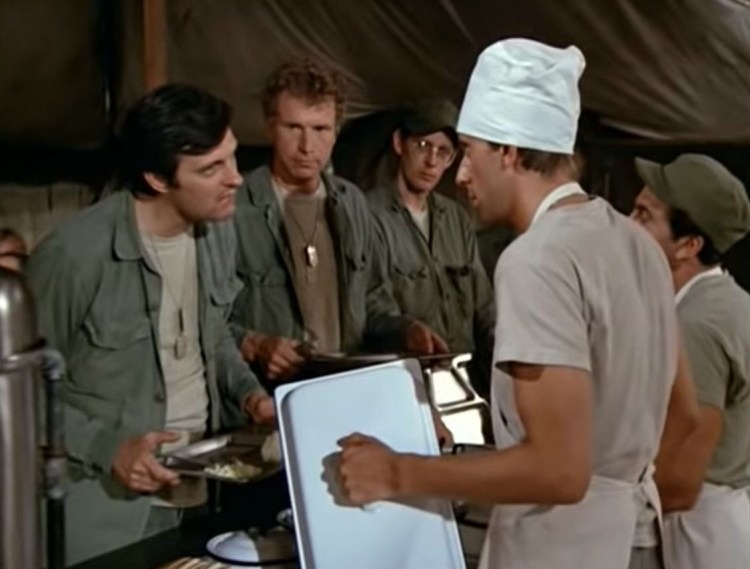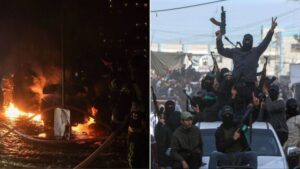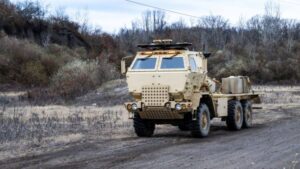The only movies I’ve seen that portrayed military food as awful were films about the American Civil War. OK, MASH too, in both the TV show and movie. But today, we take a look and see if Hollywood’s representation is accurate.
Rock Bread
For the American Civil War soldier, hardtack was a staple. It was basically bread almost as hard as a rock, so it would not go wrong. It was not unheard of for meat rations at the time (if they could get them) to contain maggots. In fact, it was pretty typical. Extra protein.
Hardtack was made of only three ingredients (water, flour, and salt), so it’s pretty hard to screw up that recipe. Civil War soldiers were typically given nine to ten pieces at a time as a ration. Some of the uneaten Civil War rations are said to still be edible today.
The horror of hardtack bread. If it’s bad enough to make a cartoon about, it’s got to be pretty bad. Image Credit: new.qq.com
When World War I broke out, British soldiers were offered one unappealing item: the Huntley & Palmers No.4 Army biscuit. Well-preserved examples of this product exist to this day. There is even a website out there dedicated to the many uses of this versatile food item.
Soldiers would complain that this biscuit was more challenging than their teeth. Image Credit: new.qq.com
The only movies I’ve seen that portrayed military food as awful were films about the American Civil War. OK, MASH too, in both the TV show and movie. But today, we take a look and see if Hollywood’s representation is accurate.
Rock Bread
For the American Civil War soldier, hardtack was a staple. It was basically bread almost as hard as a rock, so it would not go wrong. It was not unheard of for meat rations at the time (if they could get them) to contain maggots. In fact, it was pretty typical. Extra protein.
Hardtack was made of only three ingredients (water, flour, and salt), so it’s pretty hard to screw up that recipe. Civil War soldiers were typically given nine to ten pieces at a time as a ration. Some of the uneaten Civil War rations are said to still be edible today.
The horror of hardtack bread. If it’s bad enough to make a cartoon about, it’s got to be pretty bad. Image Credit: new.qq.com
When World War I broke out, British soldiers were offered one unappealing item: the Huntley & Palmers No.4 Army biscuit. Well-preserved examples of this product exist to this day. There is even a website out there dedicated to the many uses of this versatile food item.
Soldiers would complain that this biscuit was more challenging than their teeth. Image Credit: new.qq.com
It’s been said that these biscuits were the culinary equivalent of steel-toed boots. I wish I had come up with that one.
It boggles the mind that it took two people(Huntley & Palmers) to come up with something this bad.
Everyday use for the biscuit (instead of eating it) was to turn it into a picture frame. Image Credit: new.qq.com
Rats
C-Rations (or C-Rats) were developed in 1938 to replace reserve rations, which sustained troops during World War I. They consisted mainly of canned corned beef or bacon, cans of hardtack biscuits, and ground coffee, sugar, salt, and tobacco with rolling paper. But, unfortunately, the military still could not find a decent replacement for that damned hardtack.
Below, you’ll see a Vietnam-era C-Rat that was recently opened. Have a quick look, and guess what it is.
If you guessed “spaghetti,” you’d be right. Image credit: pinterest.de
Rated Red and Ukrainian MREs
In one of the funniest food-related videos I’ve ever seen, our friends at Rated Red rip open a Ukrainian MRE (all five bags worth) and try it out. Not to ruin it for you, but hardtack rears its ugly head again, and then we have what looks for all the world like dollar store catfood…the ultimate mushy mystery meat. To compliment that, we have multiple packets of “tourist snow.” Maybe that’s what’s been keeping the Ukrainians fighting so hard all this time.
Do yourself a favor and watch this video; you’ll laugh out loud.
Personal Experience
I have to say that the food I had in the Army wasn’t bad at all. It wasn’t gourmet quality, but it didn’t look like that can of spaghetti either. By the way, that spaghetti was probably made by Chef Boyardee, who was the largest supplier of food to the US military in WWII. We wrote about that here.
Meals eaten in a DFAC (dining facility) are like any other cafeteria food. However, some Special Forces-run DFACs took it up a notch. For example, 10th Group even had white linen tablecloths and served a “steak” without any visible whip marks left by a jockey.
This could be your typical college cafeteria, but it is your specific military dining facility. Image Credit: army.mil
Food in the field was, of course, different from what you’d get in the DFAC. Occasionally, we would get hot meals, which would constantly improve morale. A little hot food after a long day makes a big difference. It doesn’t matter much what it tastes like.
I didn’t care much for breakfast served in the field when it was raining (now I’m starting to sound like a sniveler). There’s not much good to be said about wet toast.
The aluminum containers where the eggs were cooked gave them a strange greenish tint. It didn’t change the flavor at all; it just looked a bit odd. Ever since I was a little kid, a pet peeve of mine has been getting shell fragments in my scrambled eggs. Crunching on something when eating eggs is just wrong. While eating scrambled eggs in the Army, you had about a 50/50 chance of getting shells. It’s not exactly the end of the world. When I’d bitch about it, my guys would razz me to no end.
Dr. Seuss must have been in the Army at some point. Image credit: TM & © Dr. Seuss Enterprises, LP 2019
One Nasty MRE
The only genuinely disgusting meal I ever had in the service was an MRE entree that went bad in the bag. That rarely happens. Almost never. I ripped off the top of the package, and the contents smelled like rotten meat. That pissed me off because we were only allowed one meal a day during that field training exercise, and my central portion smelled like roadkill.
No problem, I just munched on the rest of the MRE and made the best of it.
That’s what a good soldier does: We drive on.



